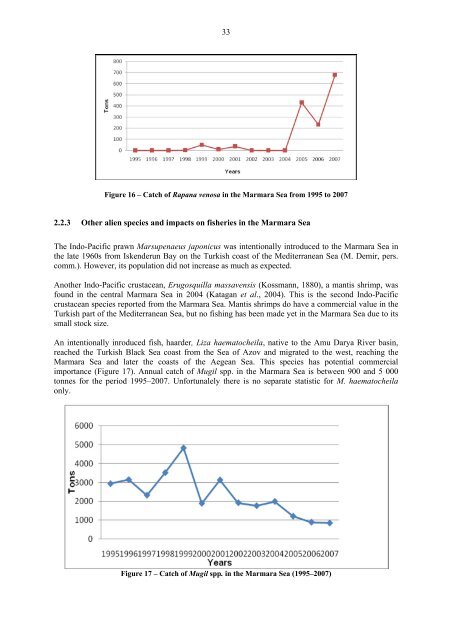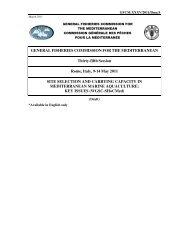Status of alien species in the Mediterranean and Black Sea
Status of alien species in the Mediterranean and Black Sea
Status of alien species in the Mediterranean and Black Sea
You also want an ePaper? Increase the reach of your titles
YUMPU automatically turns print PDFs into web optimized ePapers that Google loves.
33<br />
Figure 16 – Catch <strong>of</strong> Rapana venosa <strong>in</strong> <strong>the</strong> Marmara <strong>Sea</strong> from 1995 to 2007<br />
2.2.3 O<strong>the</strong>r <strong>alien</strong> <strong>species</strong> <strong>and</strong> impacts on fisheries <strong>in</strong> <strong>the</strong> Marmara <strong>Sea</strong><br />
The Indo-Pacific prawn Marsupenaeus japonicus was <strong>in</strong>tentionally <strong>in</strong>troduced to <strong>the</strong> Marmara <strong>Sea</strong> <strong>in</strong><br />
<strong>the</strong> late 1960s from Iskenderun Bay on <strong>the</strong> Turkish coast <strong>of</strong> <strong>the</strong> <strong>Mediterranean</strong> <strong>Sea</strong> (M. Demir, pers.<br />
comm.). However, its population did not <strong>in</strong>crease as much as expected.<br />
Ano<strong>the</strong>r Indo-Pacific crustacean, Erugosquilla massavensis (Kossmann, 1880), a mantis shrimp, was<br />
found <strong>in</strong> <strong>the</strong> central Marmara <strong>Sea</strong> <strong>in</strong> 2004 (Katagan et al., 2004). This is <strong>the</strong> second Indo-Pacific<br />
crustacean <strong>species</strong> reported from <strong>the</strong> Marmara <strong>Sea</strong>. Mantis shrimps do have a commercial value <strong>in</strong> <strong>the</strong><br />
Turkish part <strong>of</strong> <strong>the</strong> <strong>Mediterranean</strong> <strong>Sea</strong>, but no fish<strong>in</strong>g has been made yet <strong>in</strong> <strong>the</strong> Marmara <strong>Sea</strong> due to its<br />
small stock size.<br />
An <strong>in</strong>tentionally <strong>in</strong>roduced fish, haarder, Liza haematocheila, native to <strong>the</strong> Amu Darya River bas<strong>in</strong>,<br />
reached <strong>the</strong> Turkish <strong>Black</strong> <strong>Sea</strong> coast from <strong>the</strong> <strong>Sea</strong> <strong>of</strong> Azov <strong>and</strong> migrated to <strong>the</strong> west, reach<strong>in</strong>g <strong>the</strong><br />
Marmara <strong>Sea</strong> <strong>and</strong> later <strong>the</strong> coasts <strong>of</strong> <strong>the</strong> Aegean <strong>Sea</strong>. This <strong>species</strong> has potential commercial<br />
importance (Figure 17). Annual catch <strong>of</strong> Mugil spp. <strong>in</strong> <strong>the</strong> Marmara <strong>Sea</strong> is between 900 <strong>and</strong> 5 000<br />
tonnes for <strong>the</strong> period 1995–2007. Unfortunalely <strong>the</strong>re is no separate statistic for M. haematocheila<br />
only.<br />
Figure 17 – Catch <strong>of</strong> Mugil spp. <strong>in</strong> <strong>the</strong> Marmara <strong>Sea</strong> (1995–2007)
















